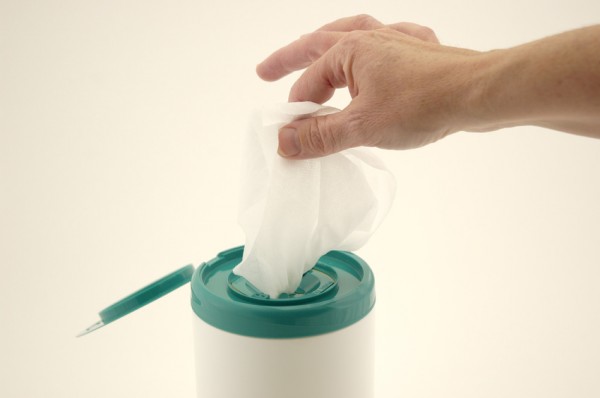Wipe-out for disposable wipes?
10/12/2013
While the market for disposable nonwoven wipes is growing continuously, disposal problems of these products are increasing at the same pace. Clogging issues caused by the common practice of flushing wipes down the toilet are placing the industry under enormous pressure. Identification of solutions that enhance the flushability properties of wipes is a challenging future topic – and a highly interesting business opportunity.
In London, Thames Water Utilities spends annually EUR 14 M on clearing its sewerage system from blockages and waste water utilities in Canada estimate the costs caused by clogging problems country-wide at EUR 200 M. 70% of clogging issues are attributed to wipes. Most of these wipes found in sewage are polymer-based spunlace products that are not intended to be thrown into the toilet. Only few wipes are labeled as “flushable”. These are moist toilet tissue and a few femcare and cleaning wipes that are small enough (‘flushable by size’). These products are made of cellulose-based wetlaid (e.g. Suominen’s Hydraspun®) or airlaid (e.g. Kimberly Clark) materials.In 2008, INDA and EDANA issued the first Guidance Document to help wipes manufacturers to assess whether their products could be flushed into the wastewater stream or not. The latest edition of the Guidance Document dating from June 2013 includes seven tests which have to be passed to claim a product “flushable”. Products that do not meet these guidelines have to be labeled “Do not flush”.In view of the immense costs caused by sewage blockages, wastewater companies are stepping up their pressure on the wipes industry. They argue that not only non-flushable labeled products that are flushed are an issue but also those that are labeled “flushable”, as most of these wipes do not disperse sufficiently. To make the dimensions clear: The total global market for wet wipes will grow from 900,000 tons today to 1.4 million tons in 2018. One child alone needs on average 11,000 baby wipes before potty training.To tackle the flushability issue, four approaches are targeted:
The wipes-producing industry will have to react to the increased pressure from municipalities and wastewater companies that is threatening the business success of the promising wipes business. Therefore, the identification of feasible solutions that enhance the flushability properties of wipes is a challenging future topic – and a highly interesting business opportunity.With many years of experience in the nonwoven industry and our excellent network of interview targets, Schlegel and Partners is one of the key B2B market research institutes in the nonwoven segment:We support customers from several value chain steps with e.g.
- Enhanced dispersibility: based on water-soluble fibers and / or binders, or nonwoven processes that allow for an easy disintegration of the nonwoven web
- Biodegradable materials: e.g. PLA fibers (fast break up in the wastewater stream required)
- Chemical treatments: chemical or biological agents that act directly in the toilet (need to be harmless for the sewerage system)
- Mechanical measures: shredding mechanisms in the toilet
The wipes-producing industry will have to react to the increased pressure from municipalities and wastewater companies that is threatening the business success of the promising wipes business. Therefore, the identification of feasible solutions that enhance the flushability properties of wipes is a challenging future topic – and a highly interesting business opportunity.With many years of experience in the nonwoven industry and our excellent network of interview targets, Schlegel and Partners is one of the key B2B market research institutes in the nonwoven segment:We support customers from several value chain steps with e.g.
- Market exploration
- Market volume assessment
- Sales support strategies